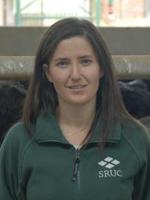Introduction
Agriculture is currently the second largest source of greenhouse gases in the Scottish economy. As a consequence of the ambitious targets for reducing greenhouse gas emissions set out in the Climate Change Act in 2009 there is an urgent need to develop new and effective greenhouse gas mitigation measures. These measures cover the wide range of agricultural practices carried out in Scotland and target the three main greenhouse gases nitrous oxide, methane, and carbon dioxide. The work is focused largely in grasslands, which are the predominant agricultural land use in Scotland. Work carried out in this programme is part of a wider national and international programme of research addressing the climate change challenge, and the need to develop farming systems achieved significant mitigation against current baselines.
Aim of Research
The aim of this work is to develop novel approaches to greenhouse gas mitigation in the crop and livestock sectors though improved understanding of underlying processes, and to assess the mitigation potential of new measures using field experiments and modelling in order to extrapolate the findings. The work also aims to provide policy and practical guidelines to greenhouse gas mitigation in Scottish farming, through a wide process of engagement with key stakeholders.
The research builds of previous work within the RESAS Strategic Programme and on collaborations with UK and International partners.
Progress
2021 / 2022
Research in year six of the programme is explored novel approaches to greenhouse gas mitigation including the use of biological nitrification inhibitors and their role in reducing nitrous oxide emissions a review of which has been published
(https://doi.org/10.1007/s00374-022-01631-2) . Work on the precision mapping of livestock excreta has helped improve our estimates of greenhouse gas emissions from grazed pastures (Precision Agriculture, In press). We have also worked with Chinese research scientists to assess the use of nitrification inhibitors in combination with deep placement of fertilisers to reduce nitrous oxide emissions and global scale (https://doi.org/10.1111/gcb.16198 ). A synthesis of work across the programme was developed and communicated at an international conference held in Edinburgh in March 2022 on agricultural greenhouse gas and ammonia mitigation. Work from the programme was also presented at the A3 conference in Edinburgh in April 2022 and at an international conference on greenhouse gas mitigation in Copenhagen in May 2022
Highlights:
AAB Conference on greenhouse gas and ammonia mitigation GHG and Ammonia Mitigation 2022 - Association of Applied Biologists (aab.org.uk)
Presentations to conferences in Edinburgh and Copenhagen (2022) on outputs from the research programme
A new BEIS project on biomass production as a GHG mitigation strategy
2020 / 2021
Reducing agriculture’s impact on the climate system will be critical to delivering policy targets aimed at achieving net zero emissions and also wider concerns about food security (https://doi.org/10.3389/fsufs.2021.684731). An analysis of the role of legume based cropping systems in contributing to the climate change biodiversity nutrition Nexus was reported (https://doi.org/10.3389/fsufs.2021.692137). We also showed that legume based rotations play an important role in lowering the environmental impact of crop rotations (https://doi.org/10.3389/fsufs.2021.656005) The role of system design and on greenhouse gas emissions and production efficiency were also analysed using an LCA an approach demonstrating lower greenhouse gas emissions from home-grown feed systems where mass-based allocation approaches were used (https://doi.org/10.3389/fsufs.2021.588158). work has continued on measurements of greenhouse gas emissions from the liming experiment at Kirkton. this data is currently being analysed in preparation for a publication.
Highlights:
Climate Care Cattle Farming from Land and Soil perspective. Research (virtual) seminar at Wageningen University. Bob Rees, Paul Hargreaves and Vera Eory. April 2021
Soil Carbon in agricultural soils; A Scottish Perspective. Bob Rees, NFU Seminar August 2021
Improving the UK Agricultural Greenhouse Gas Inventory Research Seminar, Dave Chadwick and Bob Rees. Aarhus University, Denmark, February 2021
UK-Argentina Workshop on cooperation in agricultural and climate change research. April 2021
2019 / 2020
Work continued on measurements of greenhouse gas emissions from a grassland site at the Kirkton farm to assess the impact of liming on GHG emissions. Interim results from this work were presented at a meeting in Clermont-Ferrand in February 2020. An analysis of GHG emissions from grazed grasslands showed that there are interactions between fertiliser N applications and urine deposition by livestock that lead to the development of hotspots of emissions (Maire et al 2020). Work has been undertaken comparing greenhouse gas emissions form the farming systems on our Crichton site. This has led to the preparation of a manuscript illustrating how allocation methods used in LCA accounting can influence the carbon footprints of agricultural products (March 2020, in preparation). A summary of novel mitigation approaches and their contribution to net zero emission targets was presented at an international conference in New Zealand in February 2020 (Rees et al 2020).
Highlights:
- A presentation to an international conference on the role of greenhouse gas mitigation in achieving net zero emissions targets
- A presentation to NFUS 1.5 Committee on agricultural greenhouse gas mitigation
- A new contract awarded by the Centre of Excellence in Innovation in Livestock being led from SRUC on the role of livestock in contributing to UK greenhouse gas emissions
2018 / 2019
The James Hutton research Institute have continued monitoring crop production and greenhouse gas emissions at their Centre for Sustainable Cropping near Dundee to help understand how optimised rotational management can improve resource use efficiency and greenhouse gas mitigation. This work was demonstrated at an open day on 30 May 2018.
A joint programme of research involving SRUC, and JHI has completed an initial experimental programme of work –based had a field site near Edinburgh that has focussed on the role of liming in greenhouse gas mitigation. This work was reported at an international research meeting held in Dublin in March 2019. A second phase of this work is now under way focusing on a new site at the Hill and Mountain Research centre near Crianlarich.
Highlights:
Bob Rees was invited to give evidence to the Committee on Climate Change at their meeting in Edinburgh on 13 July, 2018 at which they were considering the Scottish Government’s progress towards meeting their targets on greenhouse gas mitigation in agriculture.
Roseanna Cunningham the Cabinet Secretary for Climate Change in Land Reform visited SRUC is research facilities the Bush estate in March 2019 to discuss work on greenhouse gas measurement and mitigation with staff involved in the Scottish Governments Strategic Research Programme.
Research staff from the programme were successful in competing as part of a large UK consortium led by the Centre for Ecology and Hydrology in bidding for a large new programme on improving the sustainability of nitrogen use in S Asia. This work builds strongly on the research expertise developed within the Strategic Programme
2017 / 2018
An experiment was established at the Bush estate near Edinburgh to investigate the role of liming and soil management as a greenhouse gas mitigation approach. Samples were also collected for analysis of the pH, nutrient and microbial properties of the soil, and forage samples were analysed for nutrient and energy content. Analysis of the first year’s data was completed, and was presented to a European Conference on Precision Agriculture (July 2017) and discussed at two end user meetings (Grassland advisors, Jan 2018, Grass Seed Trade, May 2018).
Over 100 Angus breeders visited the GreenCow facility on 24th June 2017 and toured 4 separate displays about measurement and reduction of methane emissions through diet changes and breeding, as well as indirect reductions of methane emissions through breeding and the use of precision livestock farming technologies to increase feed efficiency and improve health. Presentations of work on direct and indirect approaches to reduce methane emissions intensity given to stakeholders.
Highlights:
SRUC Beef Research team worked with Scottish Government social media team to produce a short video about our work on GHG produced with Reuters TV and available on the internet here.
2016 / 2017
Improved approaches to modelling greenhouse gas emissions from agricultural systems were developed. This has allowed us to define more precisely the emissions associated with fertiliser and manure additions to farming systems (Myrgiotis et al 2016; Fitton et al 2017). Work has also been undertaken to assess the importance of carbon sequestration to greenhouse gas mitigation in work that was presented to a meeting of the Royal Society in Oct 2017. Practical approaches to the mitigation of nitrous oxide emissions in grazing systems using a decision support framework were proposed in work published in September 2017 (van der Weerden et al 2017), and have been presented at two end user events.
Work was undertaken to develop our understanding of the link between animal health and greenhouse gas emissions, focussing on methane emissions from ruminant livestock, and manure emissions derived from feed inefficiencies from monogastric farm animals and providing the opportunity to deliver mitigation through more efficient production systems.
Highlights:
SRUC has played a leading role in the UK’s Greenhouse gas platform research programme. The programme supported by the Scottish Government and DEFRA sought to improve the accuracy and resolution of our reporting system by providing new experimental evidence on the factors affecting emissions and statistics relevant to changing farming practices in the UK. It has provided evidence for a UK specific method of calculating methane and nitrous oxide emissions that will reflect the adoption of mitigation practices by the industry, enabling the forecasting and monitoring of performance against target emissions reductions set by the UK and Scottish Governments’ Climate Change Acts. The new reporting approach is reflected in the current Government reporting of national GHG emissions in 2016, which the UK is legally required to submit to the United Nations Framework convention on Climate Change. Research in this area builds upon previous research, combining field experimentation, modelling and scoping of data sources to fill knowledge gaps.
Future Activities
The final year of the programme will focus on analysis and interpretation of data collected over the research programme with a view to synthesising some of the work undertaken over the past five years. The set includes preparation for an end of programme research conference to be scheduled for March 2022 which highlights of the programme will be presented to a wider audience. Work within this programme will be reported to the scientific community through research publications and attendance at relevant conferences. Will also communicate with policy, industry and the wider public through a wide range of communication channels.
Selected Outputs
2016/17
Bartley D.J., Skuce P.J., Zadoks R.N., Macleod M., 2016. Endemic sheep and cattle diseases and greenhouse gas emissions. Advances in Animal Biosciences 7(03), 253-255.
Fitton,N., Datta,A., Cloy,J.M., Rees,R.M., Topp,C.F.E., Bell,M.J., Cardenas,L.M., Williams,J., Smith,K. & Thorman,R. 2017. Modelling spatial and inter-annual variations of nitrous oxide emissions from UK cropland and grasslands using DailyDayCent. Agriculture, Ecosystems & Environment, 250, 1-11.
Llonch,P., Troy,S.M., Duthie,C.A., Somarriba,M., Rooke,J., Haskell,M.J., Roehe,R. & Turner,S.P. 2016. Changes in feed intake during isolation stress in respiration chambers may impact methane emissions assessment. Animal Production Science.
Lee,M.A., Todd,A., Sutton,M.A., Chagunda,M.G., Roberts,D.J. & Rees,R.M. 2017. A time-series of methane and carbon dioxide production from dairy cows during a period of dietary transition. Cogent Environmental Science, 3, 1385693.
Whitfield,S., Challinor,A.J. & Rees,R.M. 2018. Frontiers in Climate Smart Food Systems: Outlining the Research Space. Frontiers in Sustainable Food Systems, 2, 2.
Sykes, A.J., Topp, C.F.E., Wilson, R.M., Reid, G., and Rees, R.M. 2017. A comparison of farm-level greenhouse gas calculators in their application on beef production systems. Journal of Cleaner Production. 164, 398-409.
van der Weerden, T.J., Laurenson, S., Vogeler, I., Beukes, P.C., Thomas, S.M., Rees, R.M., Topp, C.F.E., Lanigan, G., & de Klein, C.A.M. 2017. Mitigating nitrous oxide and manure-derived methane emissions by removing cows in response to wet soil conditions. Agricultural Systems, 156, 126-138.
Scialise, A., Pappa, VA., Gelsomino, A., and Rees, R.M. 2017. Pea cultivar and wheat residues affect carbon/nitrogen dynamics in pea-triticale intercropping: A microcosms approach. Science of the Total Environment, 592, 436-450.
Badagliacca, G., Ruisi, P., Rees, R.M. & Saia, S. 2017. An assessment of factors controlling N2O and CO2 emissions from crop residues using different measurement approaches. Biology and Fertility of Soils, 53, 547-561.
Jones, S.K., Helfter, C., Anderson, M., Coyle, M., Campbell, C., Famulari, D., Di Marco, C., van Dijk, N., Topp, C.F.E., Kiese, R., Kindler, R., Siemens, J., Schrumpf, M., Kaiser, K., Nemitz, E., Levy, P., Rees, R.M., Sutton, M.A. & Skiba, U.M. 2017. The nitrogen, carbon and greenhouse gas budget of a grazed, cut and fertilised temperate grassland. Biogeosciences, 14, 2069–2088.
Iannetta, P.P.M., Young, M., Bachinger, J., Bergkvist, G., Doltra, J., Lopez-Bellido, R.J., Monti, M., Pappa, V.A., Reckling, M., Topp, C.F.E., Walker, R.L., Rees, R.M., Watson, C.A., James, E.K., Squire, G.R. & Begg, G.S. 2016. A Comparative Nitrogen Balance and Productivity Analysis of Legume and Non-legume Supported Cropping Systems: The Potential Role of Biological Nitrogen Fixation. Frontiers in Plant Science, 7, 1700.
Rees, R.M., Barnes, A.P. & Moran, D. 2016. Sustainable intensification: the pathway to low carbon farming? Regional Environmental Change, 16, 2253-2255.
Bell, M.J., Hinton, N.J., Cloy, J.M., Topp, C.F.E., Rees, R.M., Williams, J.R., Misselbrook, T.H. & Chadwick, D.R. 2016. How do emission rates and emission factors for nitrous oxide and ammonia vary with manure type and time of application in a Scottish farmland? Geoderma, 264, 81-93.
Myrgiotis Vasileios, Williams, M., Rees, R.M., Smith, K., Thorman, R., and Topp, C.F.E. 2016. Model evaluation in relation to soil N2O emissions: An algorithmic method which accounts for variability in measurements and possible time lags. Environmental Modelling & Software 84, 251-262. 2016.
2017/18
Chadwick,D.R., Cardenas,L.M., Dhanoa,M.S., Donovan,N., Misselbrook,T., Williams,J.R., THORMAN,R.E., McGeough,K.L., Watson,C.J., Bell,M., Anthony,S.G. & Rees,R.M. 2018. The contribution of cattle urine and dung to nitrous oxide emissions: Quantification of country specific emission factors and implications for national inventories. Science of the Total Environment, 635, 607-617.
Gao,B., Huang,T., Ju,X., Gu,B., Huang,W., Xu,L., Rees,R.M., Powlson,D.S., Smith,P. & Cui,S. 2018. Chinese cropping systems are a net source of greenhouse gases despite soil carbon sequestration. Global Change Biology, 24, 5590-5606.
Maire,J., Gibson-Poole,S., Cowan,N., Reay,D.S., Richards,K.G., Skiba,U., Rees,R.M. & Lanigan,G.J. 2018. Identifying Urine Patches on Intensively Managed Grassland Using Aerial Imagery Captured From Remotely Piloted Aircraft Systems. Frontiers in Sustainable Food Systems., 2, 10.
Abdalla,M., Hastings,A., Chadwick,D.R., Jones,D.L., Evans,C.D., Jones,M.B., Rees,R.M. & Smith,P. 2018. Critical review of the impacts of grazing on soil organic carbon storage and other soil quality indicators in extensively managed grasslands. Agriculture, Ecosystems and Environment, 253, 62-81.
Sandor,R., Ehrhardt,F., Brilli,L., Carozzi,M., Recous,S., Smith,P., Snow,V., Soussana,J.F., Dorich,C.D., Fuchs,K., Fitton,N., Gongadze,K., Klumpp,K., Liebig,M., Martin,R.l., Merbold,L., Newton,P.C.D., Rees,R.M., Rolinski,S. & Bellocchi,G. 2018. The use of biogeochemical models to evaluate mitigation of greenhouse gas emissions from managed grasslands. Science of the Total Environment, 642, 292-306.
Song,X., Liu,M., Ju,X., Gao,B., Su,F., Chen,X. & Rees,R.M. 2018. Nitrous Oxide Emissions Increase Exponentially When Optimum Nitrogen Fertilizer Rates Are Exceeded in the North China Plain. Environmental Science & Technology, 52, 12504-12513.
Myrgiotis,V., Rees,R.M., Topp,C.F. & Williams,M. 2018. A systematic approach to identifying key parameters and processes in agroecosystem models. Ecological Modelling, 368, 344-356.
Myrgiotis,V., Williams,M., Topp,C.F. & Rees,R.M. 2018. Improving model prediction of soil N2O emissions through Bayesian calibration. Science of the Total Environment, 624, 1467-1477.
2018/19
Auffret,M.D., Stewart,R., Dewhurst,R.J., Duthie,C.A., Rooke,J.A., Wallace,R.J., Freeman,T.C., Snelling,T.J., Watson,M. & Roehe,R. 2018. Identification, Comparison, and Validation of Robust Rumen Microbial Biomarkers for Methane Emissions Using Diverse Bos Taurus Breeds and Basal Diets. Frontiers in Microbiology, 8, 2642.
Cardenas,L.M., Bhogal,A., Chadwick,D.R., McGeough,K., Misselbrook,T., Rees,R.M., THORMAN,R.E., Watson,C.J., Williams,J.R., Smith,K.A. & Calvet,S. 2019. Nitrogen use efficiency and nitrous oxide emissions from five UK fertilised grasslands. Science of the Total Environment.
Llonch,P., Somarriba,M., Duthie,C.A., Troy,S., Roehe,R., Rooke,J., Haskell,M.J. & Turner,S.P. 2018a. Temperament and dominance relate to feeding behaviour and activity in beef cattle: implications for performance and methane emissions. 2018/04/02, 2639-2648.
Llonch,P., Troy,S.M., Duthie,C.A., Somarriba,M., Rooke,J., Haskell,M.J., Roehe,R. & Turner,S.P. 2018b. Changes in feed intake during isolation stress in respiration chambers may impact methane emissions assessment. Animal Production Science, 58, 1011-1016.
Stewart,R.D., Auffret,M.D., Warr,A., Wiser,A.H., Press,M.O., Langford,K.W., Liachko,I., Snelling,T.J., Dewhurst,R.J., Walker,A.W., Roehe,R. & Watson,M. 2018. Assembly of 913 microbial genomes from metagenomic sequencing of the cow rumen. Nature Communications, 9, 870.
Miller,G.A., Rees,R.M., Griffiths,B.S., Ball,B.C. & Cloy,J.M. 2019. The sensitivity of soil organic carbon pools to land management varies depending on former tillage practices. Soil and Tillage Research, 189, 236-242.
Revill, A., Florence, A., Hoad, S., Rees, R., MacArthur, A., and Williams, M. UAV-Based Approaches for Crop Parameter Retrievals. 8820-8821. 22-7-2018.
Zhu,G., Song,X., Ju,X., Zhang,J., Muller,C., Sylvester-Bradley,R., Thorman,R.E., Bingham,I. & Rees,R.M. 2019. Gross N transformation rates and related N2O emissions in Chinese and UK agricultural soils. Science of the Total Environment, 666, 176-186.
2019/2020
Maire,J., Krol,D., Pasquier,D., Cowan,N., Skiba,U., Rees,R.M., Reay,D., Lanigan,G.J. & Richards,K.G. 2020a. Nitrogen fertiliser interactions with urine deposit affect nitrous oxide emissions from grazed grasslands. Agriculture, Ecosystems & Environment, 290, 106784.
Miller,G.A., Rees,R.M., Griffiths,B.S. & Cloy,J.M. 2020. Isolating the effect of soil properties on agricultural soil greenhouse gas emissions under controlled conditions. 36, 285-298.
Rees, R. M., Eory, V., Bell, J., Topp, C. F. E., Sykes, A., MacLeod, M., Misselbrook, T., Cardenas, L., Chadwick, D. R., Sohi, S., Manning, A., and Smith, P. How far can greenhouse gas mitigation take us towards net zero emissions in agriculture? Chistensen, C. L., Home, D. J., and Singh, R. 2020. Palmerston North, New Zealand, Massey University. Farm Landscapes Research Centre Conference.
Thorman,R.E., Nicholson,F.A., Topp,C.F.E., Bell,M.J., Cardenas,L.M., Chadwick,D.R., Cloy,J.M., Misselbrook,T.H., Rees,R.M., Watson,C.J. & Williams,J.R. 2020. Towards Country-Specific Nitrous Oxide Emission Factors for Manures Applied to Arable and Grassland Soils in the UK. Frontiers in Sustainable Food Systems, 4, 62.Thorman, R. E., Nicholson, F. A., Topp, C. F. E., Bell, M. J., Cardenas, L. M., Chadwick, D. R., Cloy, J. M., & Misselbrook, T. H. (2020). Towards Country-Specific Nitrous Oxide Emission Factors for Manures Applied to Arable and Grassland Soils in the UK. Frontiers in Sustainable Food Systems, 4(May), 1–19. https://doi.org/10.3389/fsufs.2020.00062
2020/21
Paterson, K., Cloy, JM., Rees, RM., Baggs, E. M., Martineau, H., Fornara, D., MacDonald, A. J. & Buckingham, S., 27 Jan 2021, Estimating maximum fine-fraction organic carbon in UK grasslands. In: Biogeosciences. 18, 2, p. 605-620 16 p
Zhang, C., Rees, RM. & Ju, X., 1 Jul 2021, Cropping system design can improve nitrogen use efficiency in intensively managed agriculture. In: Environmental Pollution. 280, 116967
Fuchs, K., Merbold, L., Buchmann, N., Bellocchi, G., Bindi, M., Brilli, L., Conant, R., Dorich, C. D., Ehrhardt, F., Fitton, N., Grace, P., Klumpp, K., Liebig, M., Lieffering, M., Martin, R., Newton, P. CD., Rees, RM., Recous, S., Smith, P., Soussana, JF. & 2 others, , Evaluating the potential of legumes to mitigate N2O emissions from permanent grassland using process-based models. Dec 2020, In: Global Biogeochemical Cycles. 34, 12, p. 1-36 36 p., e2020GB006561.
Iannetta, P. PM., Hawes, C., Begg, G. S., Maass, H., Ntatsi, G., Savvas, D., Vasconcelos, M., Hamann, K., Williams, M., Styles, D., Toma, L., Shrestha, S., Balazs, B., Kelemen, E., Debeljak, M., Trajanov, A., Vikers, R. & Rees, RM., 23 Jul 2021, A Multifunctional Solution for Wicked Problems: Value-Chain Wide Facilitation of Legumes Cultivated at Bioregional Scales Is Necessary to Address the Climate-Biodiversity-Nutrition Nexus. In: Frontiers in Sustainable Food Systems. 5, 692137.
March, MD., Hargreaves, PR., Rees, RM. & Sykes, AJ., 30 Apr 2021, Effect of nutritional variation and LCA methodology on the carbon footprint of milk production from Holstein Friesian dairy cows: Uncertainty and Allocation Effect Milk Footprints. In: Frontiers in Sustainable Food Systems. 5, 588158.
Heidecke, C., Wollenberg, E. & Rees, RM., 30 Apr 2021, Increasing the Ambition of Climate Change Mitigation in Agriculture whilst Meeting the Sustainable Development Goals (SDGs) and Food Policy Aims. In: Frontiers in Sustainable Food Systems. 5, 684731.
Costa, M., Reckling, M., Chadwick, D. R., Rees, RM., Saget, S., Williams, M. & Styles, D., 13 Apr 2021, Legume-modified rotations deliver nutrition with lower environmental impact. In: Frontiers in Sustainable Food Systems. 5, 656005.
Myrgiotis, V., Blei, E., Clement, R., Jones, SK., Keane, B., Lee, M. A., Levy, P. E., Rees, RM., Skiba, U. M., Smallman, T. L., Toet, S. & Williams, M., Sep 2020, A model-data fusion approach to analyse carbon dynamics in managed grasslands. In: Agricultural Systems. 184, 102907.
Grace, P., van der Weerden, T., Rowlings, D., Scheer, C., Brunk, C., Kiese, R., Butterbach-Bahl, K., Rees, RM., Robertson, P. & Skiba, U. M., Sep 2020, Global research alliance N2O chamber methodology guidelines: Considerations for automated flux measurement. In: Journal of Environmental Quality. 49, 5, p. 1126-1140 15 p.
Venterea, R., Petersen, S., de Klein, C. AM., Noble, A., Rees, RM., Gamble, J., Parkin, T. & Pedersen, A., Sep 2020, Global Research Alliance N2O chamber methodology guidelines: Flux calculations. In: Journal of Environmental Quality. 49, 5, p. 1141-1155 15 p.
2021/22
de Klein,C., Bowatte,S., Simon,P., Arango,J., Cardenas,L.M., Chadwick,D.R., Pijlman,J., Rees,R.M., Richards,K., Subbarao,G.V. & Whitehead,D. 2022. Accelerating the development of biological nitrification inhibition as a viable nitrous oxide mitigation strategy in grazed livestock systems. Biology and Fertility of Soils, In Press.
McNicol,L., Williams,A.P., Styles,D., Rees,R.M. & Chadwick,D. 2022. 14. Strategies to reach zero carbon beef and sheep production on Welsh farms. Animal - science proceedings, 13, 8-9.
Revill,A., Myrgiotis,V., Florence,A., Hoad,S., Rees,R., MacArthur,A. & Williams,M. 2021. Combining Process Modelling and LAI Observations to Diagnose Winter Wheat Nitrogen Status and Forecast Yield. 11.
Zhang,C., Song,X., Zhang,Y., Wang,D., Rees,R.M. & Ju,X. 2022. Using nitrification inhibitors and deep placement to tackle the trade-offs between NH3 and N2O emissions in global croplands. Global Change Biology.





